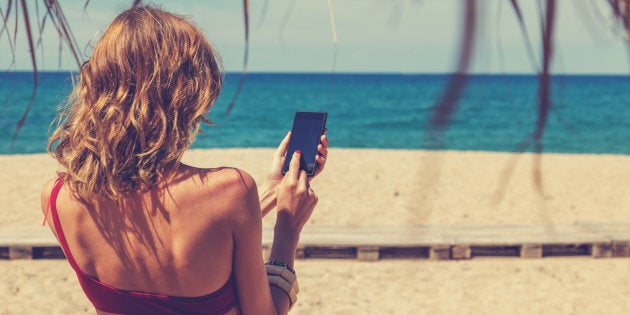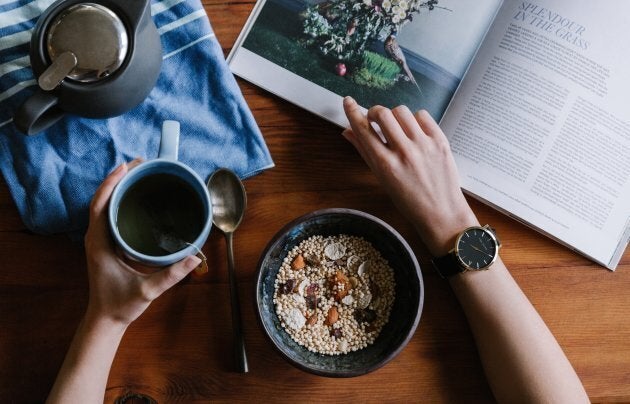
A new video is doing the rounds on social media and it's about, well, social media.
It's called 'Are You Living An Insta Lie' and it's been posted by Ditch The Label, a pro-equality and anti-bullying charity.
In the clip a girl applies some makeup before faking a just-woke-up selfie and a guy whacks a bike helmet on his head to pretend he just rode 30kms. Another bloke buys a green juice, takes a photo of it for Instagram and puts it in the bin.
Firstly, that's a little far fetched. No one in their right mind would waste $12 (which is the going price in Sydney) on a drink just to chuck it out. But while the scenarios in the video might be a little OTT, the message is certainly on point.
Social media is often a lie. It's another version of fake news. Or at least, it's not the full story. What was intended to be a way to stay connected with friends and family has become a perfect, shiny reflection of people's best lives. Though sometimes, those lives are fake.
The commercialisation of Instagram (and other social platforms) was inevitable. The glorification of everyday activities was always going to happen. But when those activities are being staged for the purpose of a photo for social media, that's when people need to start questioning their motives.
Instagram in particular has become a very lucrative outlet for some. People who have a large following are called 'Influencers' and they are paid to hold, wear or endorse products. I believe that part of the blame for the rise in people pretending that their lives are more exciting than they really are needs to be placed on these Influencers.
Many people argue that this is just a new form of advertising. That is absolutely true. But currently (very few of) these Influencers are not playing by the rules which traditional media have had to follow for decades.
I get angry when people say that it's no different to women's magazines running an advertisement. I spent 12 years of my career in women's mags, eight of those at Cosmopolitan, and can assure anyone who criticizes those titles for deceiving readers that there are very clear and strict rules enforced by the ACCC around labeling what is an ad so that it's obvious it's been paid for.

What these Influencers are currently doing is staging fake scenarios to spruik stuff. They hire a photographer and wear (or borrow) free clothes while they hold or use a product they are paid to say they like.
It's deceitful. And with feeds flooded with new cars, handbags and clothes, it's little wonder regular people are trying to emulate the images they see on social media. It's the keeping up with the Joneses of the digital age and, sadly, it's making the youth of Australia anxious and depressed.
You might think that people are clever enough to know that someone is paid to say they use a product, but that's not always true. Sometimes the messaging is purposely subtle and a lot of young and easily influenced young Aussies genuinely think that the people they follow use the teeth whiteners, protein drinks or beauty products they are posting about on their accounts.
Before I continue I have to admit I am guilty of some of these types of pictures. I'll make my husband take 10 shots before my arm looks skinny enough to post, I'll help promote a friend's new shopping website, or I'll Instagram a beauty product I trialed for work that I really like. What I won't do is receive a payment for doing so, and neither should others unless the fact it's an ad is clear to the person viewing the post.
Thankfully, things are about to change. While a few Influencers have been using the hashtag #sp (to signify a sponsored post), it's mostly just when they feel like it.
New guidelines from the Australian Association of National Advertisers, which come into effect on March 1, stipulate that Influencers must make paid posts 'clearly distinguishable' from other content and make sure they 'do not camouflage the fact that it is advertising'.
The good news is that there's plenty of room for social media and traditional media, and both have their place. Here's hoping that the introduction of these new guidelines means Influencers play fair in the world of advertising. And that, in turn, the general population can get a more truthful view on what's real and what isn't. I believe it's a moral obligation of these Influencers to be open and honest so that the general population feel less pressure to keep up.
And for the love of normality, can we all please band together and ensure that Season 3, episode 1 of Black Mirror does not become a reality? If you haven't seen it, I suggest you do.
_________________________
If you would like to submit a blog to HuffPost Australia, send a 500-800-word post through to blogteam@huffingtonpost.com.au
ALSO ON HUFFPOST AUSTRALIA